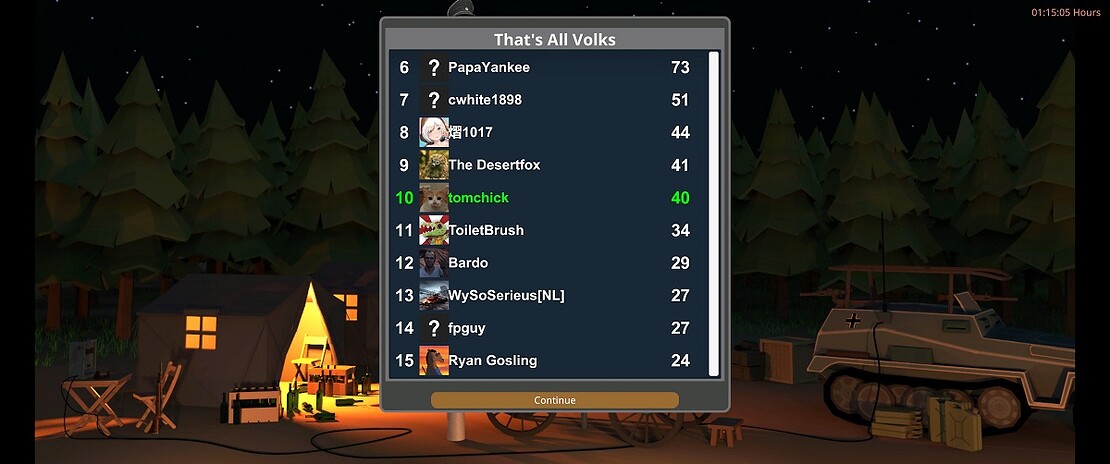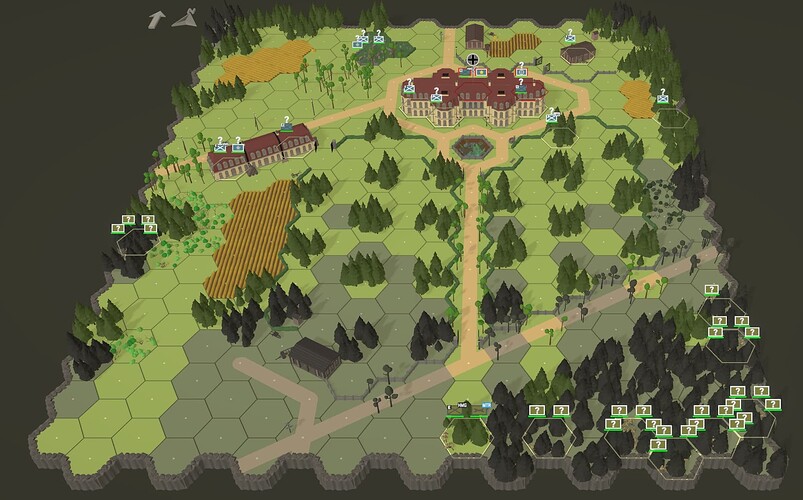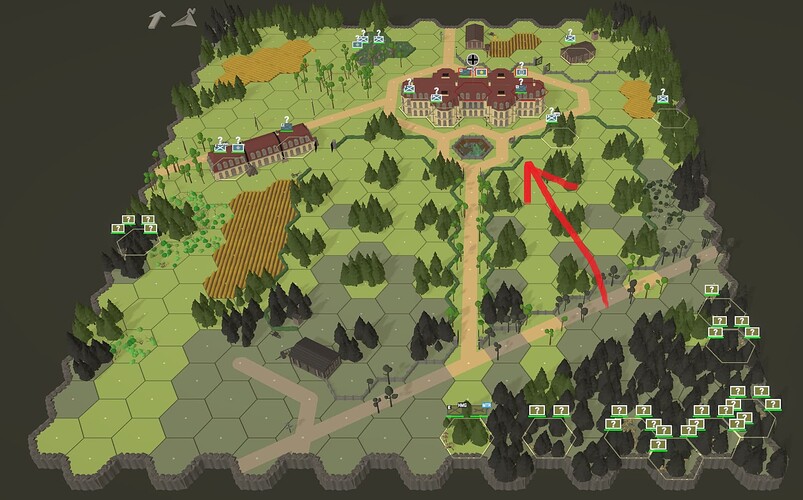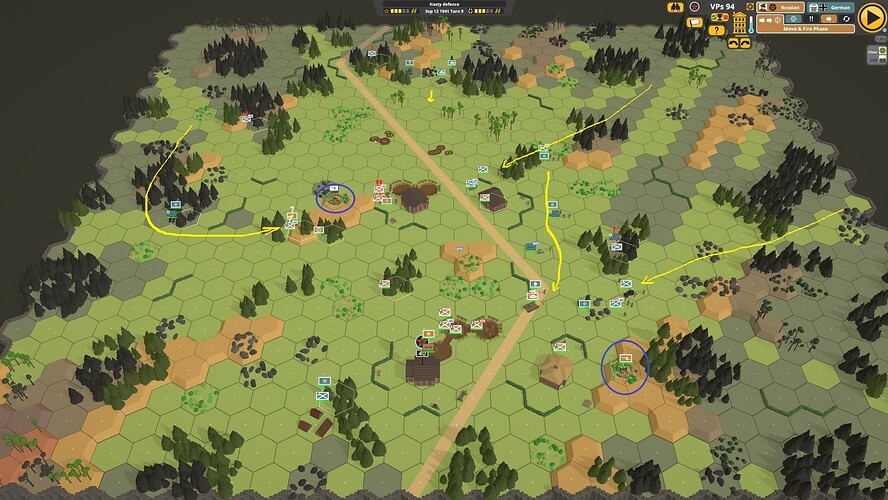It’s weird because I never used or discovered skulking despite having played ASL for many years and hundreds of hours.
Oh, I should clarify, by “not possible” I meant “not economically feasible.” We agree!
It is possible for me to live in a castle carried by five hundred elephants that have been trained to do the polka. But if I say it’s not possible, that’s shorthand for saying it’s not economically feasible.
A good AI for these games is in the similar range of economic feasibility, so forgive me if I just colloquially call it “not possible.”
That’s what’s upsetting about advances in AI – it will be developed where it makes economic sense to do so. So, instead of a robot that can do laundry, walk the dog, and paint the house, we get robots that can write. Because it makes much more economic sense to replace writers, who are expensive, with something that doesn’t have to navigate physical obstacles and won’t run the risk of stepping on your dog, which would incur lawsuits, which would be expensive.
Gaming is big business, but money will be spent primarily where it has the most potential to provide a commensurate return on investment. Sadly, turn-based WWII games from Microprose are not it. Call of Duty dialogue’s gonna get really good, though.
Maybe someday AI will get sufficiently advanced that it can replace AI programmers.
Take it up with the guy who made Second Front. He wrote a sonata and I’m interested in hearing it! I agree with your basic point, but many many many game designers apparently do not. I’m not willing to give up on all of them. :)
Ah, I did not know this! Thanks for the explanation, @sharaleo. But now I’m even more confused about some of Second Front’s design.
For instance, infantry movement. There are basically four rules: 1) All infantry get four movement points doing the Fire & Movement Phase. 1) If they run, +2 movement points but a firing malus. 3) If they have a leader, +2 movement points. 4) They can move a single space during the Advancement Phase.
Those four facts about movement are simple, flexible, and intuitive. They’re very boardgamey for being easy to remember and implement. It’s the sort of thing that once you know it, once you internalize it, you’re half way to playing. Is that from Advanced Squad Leader? The basics are really that…basic?
Yeah, that’s the saving grace for me, but that can’t be how it works in ASL, is it? Aren’t players deciding which of their units will take reaction shots at which targets? Or is it automatic in ASL as well?
And I think I’m even okay with it being a trick for human players only, mainly because I don’t think it’s a very “exploitable” situation. Now that I’m actually playing in earnest – done with tutorials, working my way through the one-star scenarios – I see a couple of mechanics that mitigate the “gamey-ness” of triggering reaction fire shots.
The first is that if a defender is so outnumbered that the attacker has the luxury of depleting reaction fire by moving distant units, the defender has bigger fish to fry than its exploitable reaction fire. At least in theory. The second factor is how machineguns work, getting a chance for a “free” second shot; I’m not sure if this comes into play during reaction fire, but if it does, it would mean you’re never sure if you’re using up the machinegun’s last reaction fire? I’m not certain about this, and the manual – I am NOT a fan of it – doesn’t say.
But mostly I’m okay with the reaction fire rules now that I realize something: this is clearly a game built to be played against the AI.
I don’t know if it’s built well, but I aim to find out since I’m enjoying the basic system, even if it’s way more simple than I expected. We take turns moving our dudes, rolling dice, assessing the tactical situation, and then doing it again. There’s no multiplayer, of course, but as far as I can tell, there are also no scenarios where you can play either side; it seems this is a game where all the scenarios are explicitly built to be played against an AI, not as a head-to-head scenarios in which the AI fills in for the missing human.
Is this a distinction without a difference? Perhaps in this case it is. But if I’m right, if this game is intentionally built for scenarios in which the AI is given a specific set of units, tasks, locations, and tactics to create a plausible and interesting challenge for the human player, then maybe the limitations of the AI won’t be a major factor? I would love to discover a viable solitaire computer wargame, and the jury’s still out whether it’s this one, but I’m not giving up yet.
Skulking! Perfect name. I’d never heard of it before.
That one bothered me, too, @pedro. But it didn’t bother me much, because it seems it’s only useful as a delaying tactic. I think in a normal situation, you’d want to leave you units in a position to blunt the attackers as they approached. But, yeah, “gamey” definitely describes it and it was weird to have the tutorial point it out:
“Hey, here’s a weird trick you can do to take advantage of our overlapping fire phases! It doesn’t approximate anything you’d see in an actual battle, or simulated in any wargame, but just a heads-up that it’s an option here! kthnxbye!”
Ugh. I’m not sure I believe the “deliberately built into the system” comment. Smacks of “uhh, yeah, we meant to do that.”
One of the recurring “tools” in Second Front’s “toolkit” is this kind of cat-and-mouse. You will be punished for not scouting, and for running units around willy-nilly, which is how it should be. I can’t speak to the specific YouTuber or scenario you saw, but I can say that modeling the perils of hidden units – and giving players the tools to deal with and use that mechanic! – is a fundamental part of Second Front. In fact, I would go so far as to say there’s a pretty hearty “stealth” system in here!
But don’t blame the game because you watched someone who didn’t know how to play it. :)
The basic rules for ASL are simple, but there are rules and exceptions for nearly everything if you want to know everything. For example, in ASL you can make a dash move if you begin and end your movement in a building and cross a road in between. Anyone firing on you in the road hex is halved (it’s been years since I’ve played, so I may be wrong on the details). You can play without that rule, but it can come in handy if you know it. Don’t know if this rule is in SF, but I doubt it.
I agree with you, but in this case I think what annoyed the streamer was the automation of the defensive fire. In cardboard play (let’s keep assuming this is mostly ASL) you wouldn’t fire a hidden AT gun at infantry with a tank on the board, hoping you can actually surprise that tank when revealing it and get a good shot.
But since defensive fire is automated, it seems that once the gun has a “good enough” shot it will fire, messing up the cat-and-mouse game.
But again, I do understand the automation (it is very suited to electronic play) so it’s a hard problem to solve. Maybe give the player (and AI/scenario designer) a way to override the “rules of engagement” of defensive fire for some units?
This explains a lot. So people around the world are playing ASL and walking their units across roads from one building to another just fine, none the wiser. But people who really know ASL’s rules instead invoke the dash rule, which applies whether your opponent knows it or not, right? Them’s the rules? So part of being an ASL player in having a head for these sorts of exceptions? I think I’m starting to ‘get’ it…
And, no, there is no “you get to dash if it’s from building-to-building across a road hex” rule in Second Front. But now I’m wondering how I would feel about that approach in a videogame. You can walk your dudes across the road normally, but there’s always a text prompt available and if you type in “dash rule”, you can use it in the game. :)
Ah, right. But as you said, that’s a facet of the reaction fire rule we’ve been talking about. And, yeah, I get that could totally mess up the concealment rules. Seems like you’d want a toggle to tell a unit with concealment not to fire, and I’m 90% certain I’ve played other wargames like that. But now we’re adding complexity, aren’t we? Where do we stop???
But I still stand by the “stealth” system, especially seeing as it was translated from a tabletop game. It seems like a pretty elegant way to have hidden movement even though the chit is right there under everyone’s nose. That’s a longtime dilemma in wargames, isn’t it? How to model hidden units and hidden movement when you can’t actually hide stuff?
Are you 100% sure. Because that’s my issue with the documentation, I can’t tell if it’s there or not. Say I’m in a building and I click move towards another building with a road hex in-between. Is that shot halved? Because it very well could under the hood.
Does the effective final fire value of a shot appear in the UI somewhere? (I confess I need more time with the game. Maybe next week will be less crazy).
And yes, the stealth system is an extremely important part of the experience, imho.
I had a castle with seventy-five elephants, but they only did the twist.
I do agree with your assessment of AI and money, too. Overall, it’s a toss up whether or when we will see that tech filter down into what really matters–games!
You know, you’re absolutely right! There’s a huge difference between “it’s not documented” and “it’s not in the game”. I have a tendency to trust documentation – old habits – so I assumed because there’s nothing in the manual or tutorial about halving “to hit” chances against building-to-building dashers, it’s not in there. But you’re absolutely right.
For the most part, though, I love the little iconography scheme for communicating bonuses and penalties. But all that reaction fire stuff is ensconced securely under the hood, isn’t it?
SIr…I need you to put this away and play Skies over Britain. I just received it while at the start of my Hoplo:Victorum campaign and I’m getting tired of all the little battles and am jonesing for a historic battle campaign game…but need to see how you are coming along with it and if it’s a recommend or not…thanks!
Right? So many distractions. I’ve been trying for a while to bury myself in a computer game, but none of them are taking so well as boardgames. And you’ll never guess what stalled my new campaign for Skies over Britain: the arrival of the latest set for the Sentinels of the Multiverse reboot, Rook City. I figured it was due later this year, but then it just shows up on my doorstep and forces me – forces me, I tell you! – to sort it and admire it and sort it some more and fold it in with the core set and do some more admiring and sorting and even run it through a match or two, leaving my Skies over Britain campaign patiently waiting on the other table. I’ll get there, @petey, and I look forward to discussing it with you. Maybe one of us should start a thread…?
Distractions! So many, good ones and family ones.
I will start reading that large manual for Britain and do those learning scenarios and see how it goes…will post some thoughts soon. Aeon’s Trespass is awaiting me also.
Back to Second Front. Bought it, hoping for some fun small unit engagements…will keep reading this thread with hopeful anticipation.
That sounds like skulking, so it truly is ASL :)
@Juan_Raigada I’m glad he is making his own thing. That ended up being the case for the Close Combat, and Combat Mission teams as well. I wonder if there ever will be a digital version.
Suck it, Gosling!
First Man, my foot. You’re not even in the Top Ten!
What you’re looking at there is the leaderboard for the only scenario I could find with the AI playing the attacker. Aka “Let’s see if the AI is any good”. Which I’m afraid it’s not, as you can see playing this scenario, where it just Leroy Jenkins a heavily defended position with its overwhelming advantage of veteran attackers. It’s basically a zombie movie, but with high morale zombies. I lost my first attempt when the results of a close combat didn’t go my way on the last phase, of the last turn, with my last unit! Gah!
So I fired up the scenario again, handily won, and furthermore placed in the top ten on the leaderboards. By a considerable margin. It’s a later scenario, so I’m sure it simply hasn’t been played by many people yet (I’ve ranked in the thousands on most of the scenarios). But it’s also where you can really see the cracks in the AI. Here’s how the scenario starts:
Your handful of soldiers occupy Chateau Rochambeau at the top of the map, with a commanding view of the grounds. A horde of Americans enters from the lower right. A human attacker would probably fan out his soldiers across the map and advance using the terrain. But the computer?
They just roll over each other like a wave, clumping up to provide convenient targets, gadding about in open terrain whenever they feel like it, and generally absorbing as much firepower as I can project while tumbling over each other and giggling and playing grab-ass and breaking and rallying and breaking and rallying again. They get to the chateau eventually. The scenario feels like it’s mathematically calculated to overwhelm you just within the allotted time limit, using sheer numbers rather than any sort of tactics or game systems. It’s just a human wave, absorbing horrific casualties because it doesn’t care about terrain.
I suppose I could play again to try to get more than 40 points. After all, isn’t Second Front a score chasing game? I’m reminded of Mage Knight, a boardgame I gave up in disgust when I realized that the only pushback was the clock. In Mage Knight, you never actually win or lose; you just come in ahead of schedule or behind schedule. The game is all about optimizing to meet the goal sooner, for more points. And that, at the time, was a real disappointment to me.
But over time, I came to appreciate Mage Knight’s design, and how it was ultimately a game about optimizing. I started playing it for other reasons, and eventually learned to accept that it was an optimization puzzle, and to appreciate it as such.
And maybe that’s where I’m heading with Second Front? If the AI doesn’t present any meaningful challenge, and since there’s no way to play against a human being, there’s no way to flex Second Front as a wargame about the drama of winning or losing. So instead, I think of it as a game about optimizing the solution to tactical puzzles. And because there are victory points, and they’re listed on a leaderboard at the end of the scenario, I wonder if the point of this game is to learn the systems and the scenarios, and then play them for the score.
But do wargamers even care about scores? Heck, I don’t even think most Mage Knight players care about scores. I suspect I’m enjoying my place on the Venn diagram of erstwhile wargamers and people who grew up playing pinball machines. So here’s me, playing a wargame with bad AI, and not even really minding too much…
To the point made earlier in the discussion that an AI can’t be expected to competently handle the complexity: If this is a single player only game what is the point really of putting a system into the game if the AI can’t handle it? Is multiplayer support on the roadmap?
Edit: I guess shiny toys for people to play with? I’m not a game designer, so I have no idea. It just seems like you would want to come up with a solution that you could get the ai to use well.
That’s very disappointing to read there’s only one scenario with the AI as the attacker and it can’t handle it. Maybe that’s the reason?
Just to clarify, I don’t think that’s the case! I’m afraid I gave the wrong impression by saying this was the “only one I could find”.
There are 48 scenarios in the game divided by which faction you’re playing: 12 as the Russians, 12 as the Americans, 12 as the Germans vs Russians, and 12 as the Germans vs Americans. They’re sorted by difficulty, and you have to unlock them by either a) playing through them, or b) pressing the big “Unlock All” button. I’ve been playing through them by difficulty level as I learn the game, and I’ve probably unlocked half of them, but I’ve only played maybe ten.
When I went to look for a scenario with the AI as the attacker, the first one I found was called “Stop the Invaders”. Unfortunately, you have to stop the invaders by attacking them. Tricky! It wasn’t until I unlocked this “That’s All Volks” scenario that the description made it clear the AI would be attacking:
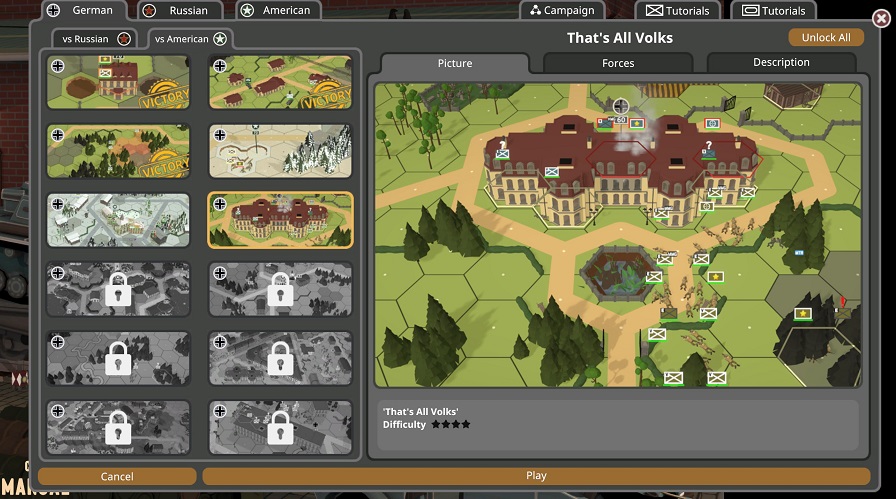
(By the way, note the difficulty level. Four stars. I believe this is as hard as it gets. And I handily beat it on my second try because I knew what the puzzle was. I didn’t even have to use “skulking”, but now I’m wondering how much that would have improved my score…)
I suspect there are other scenarios with the AI attacking, but this was the first one I could find, and it took beating three other scenarios to unlock it. But if anyone were keen to jump right to certain scenarios, there’s the “Unlock All” button on the upper right.
EDIT: Actually, did I beat it? I’m seeing how I don’t have the “Victory” placard on the scenario selection. How then did I score any points for the leaderboard? Dagnabbit, am I going to have to play this scenario a third time?
EDIT EDIT: Okay, I confused “scoring positive points” with “meeting the victory requirements”, aka “winning”. You’re going to score points chewing up the American attackers, but you won’t “win” the scenario unless you hold the chateau for nine turns. I managed to nab 10th place on the leaderboards not by winning, but by killing 40 points worth of Americans. So now I’m curious how many people have actually played “That’s All Volks”, and furthermore how many of them “won” it.
I thought zombies were already unbreakable!
That looks quite bad. I wonder if the fact that there is really only one big target contributes to that AI behaviour? For example I played the (one-star) Hasty Defense scenario (it’s the second Russian mission) and the AI gave at least the impression of great competence.
EDIT: Spoilers for a quite fun mission below, possibly. Maybe play first before reading?
I suspect the AT guns (ringed) were flagged as top priority for the AI. The troops coming from the northwest tried to flank it using cover, and the armour at the top of screen stopped until both the gun and the ATR in the centre foxholes were disabled (screenshot taken just after that team has broken). The troops coming from the northeast went after the ATR (which was incredibly ineffective in any case), while the northen armour stayed back and eventually disabled my mortars. Then reinforcements from the east made a beeline for the VP location (and the other AT gun).
So that all gave the illusion of competent AI; as I say, probably the presence of several high-value targets helped the illusion, whereas in your scenario, they all went straight for the single victory area as there wasn’t much else to prioritise. It would have been nice if they’d spread out etc.
I lost the scenario on the last turn when their mortar got 6 (SIX) reloads and broke my final defenders crammed into the VP location…so I reloaded that final turn and survived by the skin of my teeth :)
Bit exhausting at twelve turns, I was conflicted about doing a full replay straight away. So much missing of shots.
@Pedro I also lost this one on the last turn. Haven’t replayed it yet, but it was a lot of fun and a nail biter to the end.
